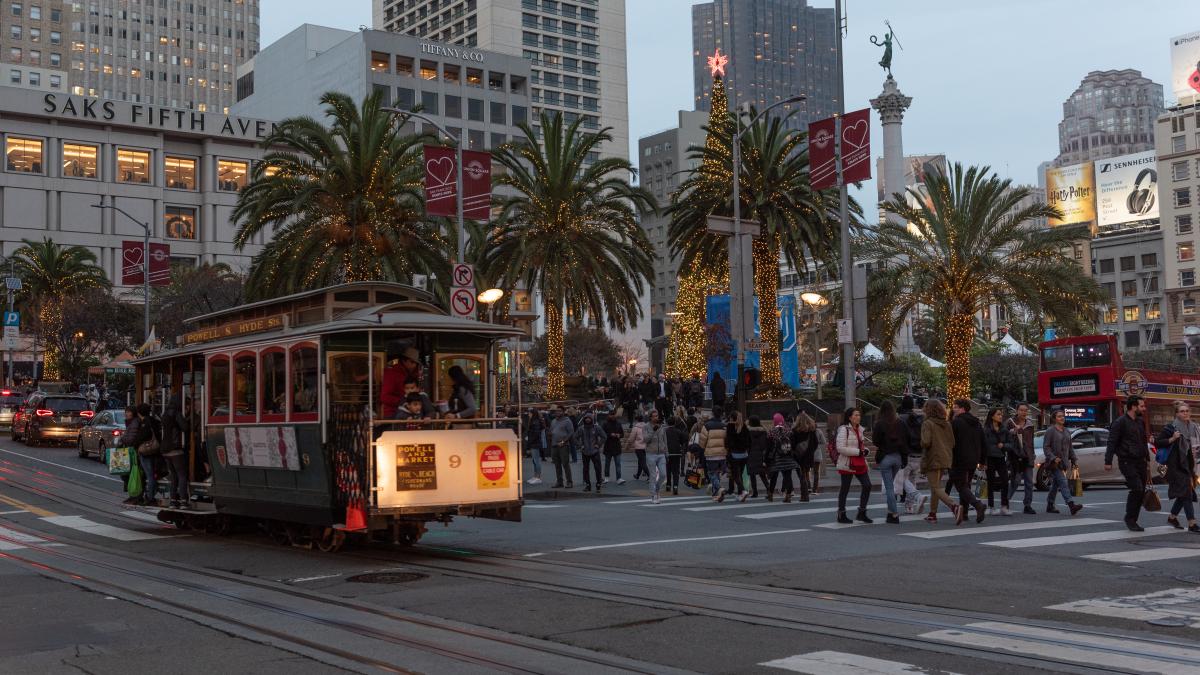By Pamela Johnson

The iconic Cable Cars are just one of the many options to get you to all the holiday festivities in Downtown Union Square!
The SFMTA would like to wish you a Happy Holidays! With festivities, dining, shopping and all the many holiday activities to choose from, Downtown Union Square, much like the rest of the city is making optimistic strides in the city’s economic recovery. Catching Muni, paratransit or a taxi to downtown supports small businesses and is a big boost to our transit goals. Below is a comprehensive list of transit and parking options to head into the heart of the downtown shopping and festivities this holiday season.
Central Subway Special Weekend Shuttle
-
The Central Subway’s Special Weekend Shuttle has got you covered on Saturday and Sunday’s every 12 minutes from 8 am to 12 am. Deboard at our new Union Square/Market Street Station. From here, you can also transfer to BART’s Powell Station, our regional transit partners.
Muni Metro Light Rail
Muni Bus Lines
-
For more information, please visit SFMTA Trip Planner.
Cable Cars
-
Invented here nearly 150 years ago and named a National Historic Landmark in 1964, hop on any of our beloved world famous Cable Cars this season. Be sure to lookout for several Cable Cars decorated in the spirit of the holidays by our dedicated and talented staff. Passengers will travel up and down the hills of San Francisco in this annual holiday tradition.
Additional Services
-
Free One-Hour Parking at Union Square Garage - the Mayor will be providing one-hour of free parking at our Union Square garage through the end of the year, regular posted rates apply thereafter. All facilities have increased staffing and security, restriped its parking spaces, and upgraded much of its overhead lighting, to make parking easier and safer this holiday.
-
Additional SFMTA parking garages - Ellis O’Farrell, Sutter-Stockton and Fifth & Mission / Yerba Buena
-
If you drive, parking in a city-owned garage may be the way to go. And parking rates at city-owned garages are typically 40% less expensive than parking prices in privately-owned garages.
-
Visit the general holiday parking advisories to learn more about holiday parking rules.
-
Visit the SFMTA’s list of city-owned parking facilities for a list of public parking garages and lots.
-
Taxi - with knowledgeable and trustworthy drivers, save some gas and catch a taxi. You’ll not only ride in a clean and safe vehicle, your taxi can use our red transit-only lanes to get to your destination quicker. And since November 9, the Taxi Upfront Fare Pilot Program has been helping customers book a taxi trip through a taxi e-hail app and pay a flat-rate, upfront fare. Being able to request a taxi through approved third-party apps provided customers with upfront information about their fares, relieve meter anxiety and allow customers to price shop for similar on-demand services.
-
Essential Trip Card - older adults, people with disabilities and other eligible participants can benefit from this discount program paying 20% of the cost of a regular cab. Don’t forget our Shop-a-Round program, a convenient, low-cost shuttle that makes it easier to go grocery shopping for all your holiday meals. The shuttle takes groups of riders to grocery stores or supermarkets in San Francisco where they want to shop. The service offers registered older adults and people with disabilities personalized assistance that is not available on Muni bus and rail lines.
-
SF Paratransit - is a van and taxi program for people unable to independently use or access public transit because of a disability or disabling health condition. Participants may also use their Essential Trip Card for this service.
For real-time updates, follow us on https://twitter.com/sfmta_muni or visit SFMTA.com/EmailText to sign up for real-time text messages or email alerts.
For details of Muni re-routes, visit SFMTA.com/Updates. This website will be updated when it is closer to the event date.
For additional notifications and agency updates, subscribe to our blogs, daily or weekly updates.
Published December 09, 2022 at 11:50PM
https://ift.tt/SqvxV17
Comments
Post a Comment